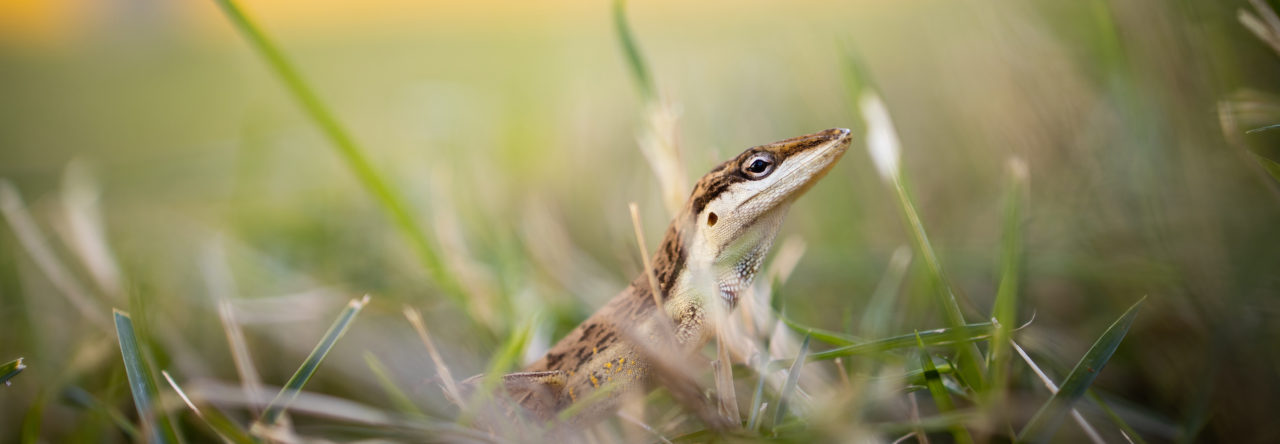Much has been made about the role of convergent morphology in the partitioning of vertical habitat by Greater Antillean anole ecomorphs. In particular, the role of toepads in allowing anoles to utilize vertical habitat space has been the focus of abundant research. It is easy to see why, given the novelty of the toepad in anoles (and, of course, geckos). But when you look across the lizard tree, there plenty of arboreal lizards lack toepads entirely and instead rely on their claws for climbing.
Functional studies in other claw-bearing squamates provide some predictions for how claws may be related to habitat use. For example, studies have shown that highly curved claws perform better in performance trials of clinging strength (Zani 2000), and so we would expect that more arboreal species should have more highly curved claws. Yet claws remain a relatively neglected trait in anoles, despite the wealth of literature related to other aspects of their ecomorphology.
Is claw morphology related to habitat partitioning in anoles? Or is it really all about the toepad? In a recent publication, my coauthors and I set out to examine how claw morphology varies across the Greater Antillean anole radiation with these questions in mind. We measured the claws and toepads of 428 museum specimens across 57 species to test the prediction that claw morphology was related to habitat use in Greater Antillean anoles. Our sampling spanned every ecomorph present on each Greater Antillean island, as well as several non-ecomorph species.
First, we tested the prediction that arboreal species should have more curved claws than terrestrial species. This pattern has been observed in squamate reptiles broadly, but has not been tested within anoles. Unfortunately, only one truly terrestrial anole exists in the Greater Antilles, A. barbouri. Therefore, to increase our sampling, we included four terrestrial mainland species. As predicted, we found that terrestrial anoles had much flatter claws than arboreal species. Claw curvature was also positive correlated with perch height

Fig 1 PCA plot of first and second principal components for univariate claw measurements. Convex hulls are depicted for each Greater Antillean ecomorph and terrestrial species (both Greater Antillean and mainland) are labelled. Insets: (A) Superimposed means of geometric morphometric shape for terrestrial and arboreal species; (B) Boxplots of claw curvature measurements for arboreal and terrestrial species (*** P < 0.001).
Next, we tested the prediction that ecomorphs are differentiated by claw morphology. We found that ecomorph did predict claw morphology, but that differences were more pronounced for some ecomorphs. Notably, more terrestrial ecomorphs (trunk-ground) were differentiated from more arboreal ecomorphs (trunk and trunk-crown) in line with predictions. In the most extreme case, twig anoles appear to have dramatically reduced claws. Their claws were not only flatter, but also shorter and thinner relative to body size compared to all other ecomorphs. We can only speculate as to the reason that this might be the case. Perhaps claws are unimportant or an impediment in twig anole locomotion? Clearly, functional studies are required to fully understand the relationship between being a twig anole and claw morphology.
Finally, we tested for patterns of covariation, or phenotypic integration, between claw and toepad traits. Claw curvature was positively correlated with toepad width and lamella number, both traits that positively correlate with perch height and demonstrated to improve clinging performance in anoles. Other claw traits such as relative length and diameter did not correlate with toepad traits. This is perhaps unsurprising, as these traits also do not appear to be differentiated between more arboreal and terrestrial species. Given the developmental literature showing that terminal digit features are decoupled from the rest of the digit (Casanova and Sanz-Ezquerro 2007), our observed pattern of integration is unlikely to be the result of developmental linkage.
In conclusion, our data suggest that integration between claw curvature and toepad traits is driven by correlative selection due to structural habitat use. Our results strongly support the hypothesis that claws play an important role in the partitioning of vertical habitat within the adaptive radiations of anoles, and suggest that they are likely shaped by similar patterns of correlative selection that have driven the evolution of ecomorphs overall. Still, we have a lot to learn about how variation in claw shape influences actual locomotor performance in anoles. Claws are a trait just waiting for more research!
Casanova, J. C., and J. J. Sanz-Ezquerro. 2007. Digit morphogenesis: is the tip different? Dev. Growth Differ. 49:479–491.
Yuan, M. L., M. H. Wake, and I. J. Wang. 2019. Phenotypic integration between claw and toepad traits promotes microhabitat specialization in the Anolis adaptive radiation. Evolution 73:231–244.
Zani, P. A. 2000. The comparative evolution of lizard claw and toe morphology and clinging performance. Journal of Evolutionary Biology 13:316–325.
















